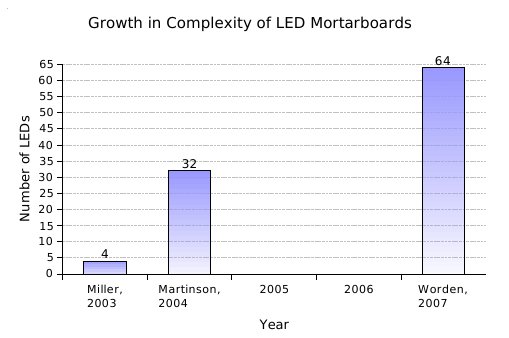LED Mortarboards—Technology Marches On!
I would like to bring to the attention of my readers an impressive technological advance made by one David Worden, lately graduated from the University of Wisconsin with a well-deserved degree in Electrical Engineering. Mr. Worden enlivened his graduation ceremony with a light show built into his mortarboard: 64 LEDs driven by a microcontroller programmed to produce a variety of animated effects. Let me be the first to congratulate Mr. Worden on his splendid achievement in Mad Science—but as a Mad Scientist myself, let me also remind the young upstart that he was not the first to have this idea!
In the long-past days of my miss-spent youth (err … 2004), I also graduated with a degree in Electrical Engineering, and sported a light-show hat of my own at the ceremony. The mortarboard had four diagonal lines of 8 white LEDs each, controlled by a central PIC microcontroller; all five circuit boards were painted black and atttached to the top of the hat with velcro. Though I must admit, Mr. Worden's design is rather more complex, with twice as many LEDs as mine and a fully-concealed circuit.
Actually, to be completely honest, I wasn't the first to have this idea either. In 2003 my good friend Mark Miller graduated BSEE wearing on his head the primitive ancestor of all LED mortarboards. This featured four engineering-orange LEDs, one on each corner, made to flash alternately by a 555 timer and a logic chip.

But enough about the past, I hear you cry—what about the future of smart-assed graduation light show hacking? Consider the figure above. Here we see a 16-fold increase in number of LEDs in only four years, which works out to a doubling of LEDs every year. That's right—LED mortarboard complexity is outstripping Moore's Law! What are the consequences for the Tawainese economy, for global consumption of 9v batteries, for graduation ceremony decorum? And will this twice-as-fast Moore's Law hold, or will we hit the much-dreaded "wall" where physical limitations prevent young engineers from packing even more LEDs onto their heads? Grave questions, my friends, grave questions!
Seriously though, a hearty congratulations, good luck, and job well done to Mr. Worden. Somebody hire him already.
